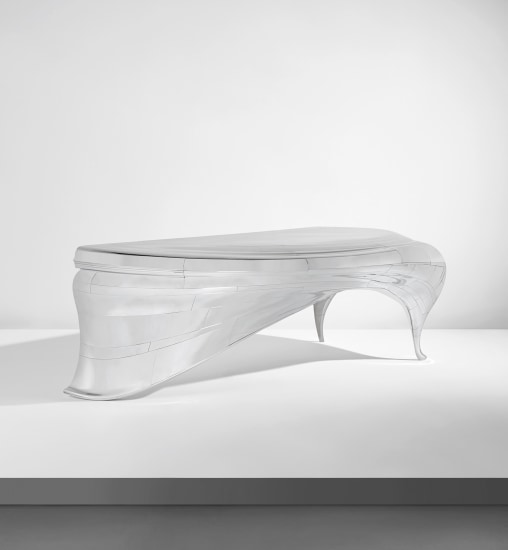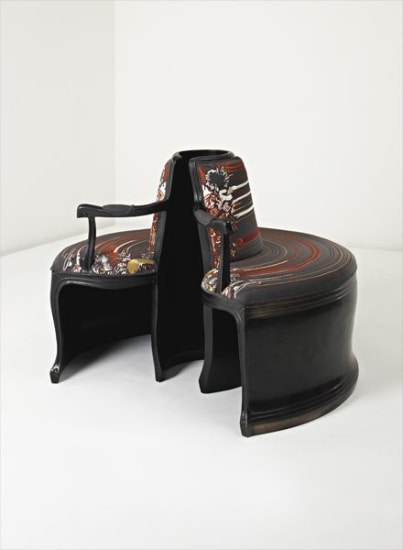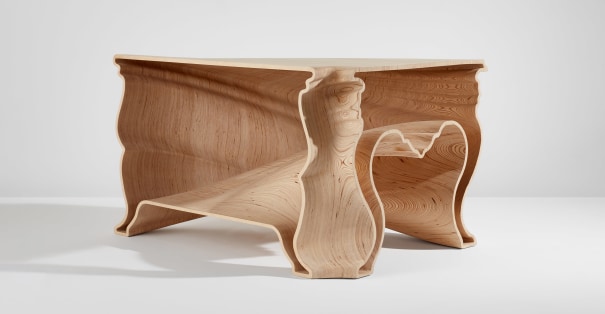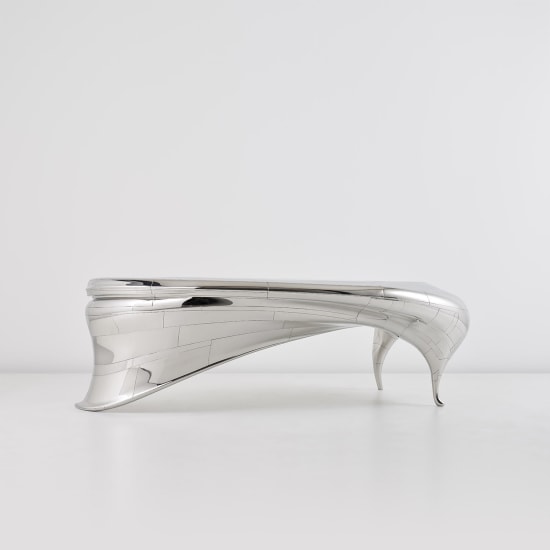PROPERTY FROM AN IMPORTANT PRIVATE COLLECTION Jeroen Verhoeven Cinderella Table 2007 CNC-cut birch plywood 31 1/2 x 51 3/4 x 41 in. (80 x 131.4 x 104 cm.) Manufactured by Id Productions for Demakersvan, the Netherlands. Number 17 from an edition of 20 plus 4 artist's proofs and 1 prototype. Serial number C-17-0807. Underside signed and dated 2009 by the artist and with a personal inscription to the owner. This work is accompanied by a certificate of authenticity signed by the artist.
Provenance Acquired directly from the artist, 2009 Literature Gareth Williams The Furniture Machine: Furniture Since 1990, London, 2006, front and back covers, pp. 110-111 Tom Dixon et al., eds, &Fork, New York, 2007, p. 123 Sarah D. Coffin, et al., eds, Rococo: The Continuing Curve, 1730-2008, New York, 2008, p. 273 Gareth Williams Telling Tales: Fantasy and Fear in Contemporary Design, exh. cat., The Victoria and Albert Museum, London, 2009, p. 73 Jeroen Verhoeven Lectori Salutem, exh. cat., Blain Southern, London, 2013, p. 12 Catalogue Essay Like a comely maid, Cinderella steps from under the folds of her rival older sisters. Dutch designer Jeroen Verhoeven’s now-celebrated beauty derives from the silhouettes of two eighteenth-century works, what appears to be a bombé commode with serpentine sides and a console with shaped apron above cabriole legs. But as in Charles Perrault’s 1697 fable, Cinderella is cut from a different cloth, birch plywood to be precise. Her stepsisters would have flaunted thin veneers over less noble woods. Here, beauty is more than skin deep. Verhoeven uses humble ply—CNC-cut, bonded, and finished by hand—to exquisite effect, inside and out (the insides are in fact outside). Like its namesake, the table hides no unpleasant traits, no awkward joints, no declensions of spirit. Cinderella Table appeared in the Cooper-Hewitt’s 2008 survey Rococo: The Continuing Curve, 1730-2008, a celebration of the period, its revivals, and its ongoing influence. Beyond the direct inspiration of eighteenth-century furniture, the table’s energetic curves recall the convolutions of rococo, a style unapologetic in its appeal to surface decoration and exuberance, like the shell motifs and fluid asymmetry of a Meissonier tureen, or the cresting wave handles on Sèvres tableware. But Verhoeven references the innovations of later centuries too, both nineteenth-century bentwood furniture and twentieth-century Modernism’s elevation of technology and everyday materials. Verhoeven’s use of plywood and computer numerical control technology is heir to the radical 1930s inventions of Alvar Aalto and Gerald Summers (the Cooper-Hewitt included birch plywood chairs by both designers). To borrow from Ellen Lupton, one of the show’s curators, Verhoeven is both “abstract and referential”, in keeping with contemporary fashion. Beyond that, his table is evidence of the timeless human aspiration for beauty and pleasure, an unbroken spell. The Cinderella Table is in the permanent collections of The Museum of Modern Art, New York, The Brooklyn Museum of Art, Le Centre Pompidou, Paris and The Victoria and Albert Museum, London. Read More
PROPERTY FROM AN IMPORTANT PRIVATE COLLECTION Jeroen Verhoeven Cinderella Table 2007 CNC-cut birch plywood 31 1/2 x 51 3/4 x 41 in. (80 x 131.4 x 104 cm.) Manufactured by Id Productions for Demakersvan, the Netherlands. Number 17 from an edition of 20 plus 4 artist's proofs and 1 prototype. Serial number C-17-0807. Underside signed and dated 2009 by the artist and with a personal inscription to the owner. This work is accompanied by a certificate of authenticity signed by the artist.
Provenance Acquired directly from the artist, 2009 Literature Gareth Williams The Furniture Machine: Furniture Since 1990, London, 2006, front and back covers, pp. 110-111 Tom Dixon et al., eds, &Fork, New York, 2007, p. 123 Sarah D. Coffin, et al., eds, Rococo: The Continuing Curve, 1730-2008, New York, 2008, p. 273 Gareth Williams Telling Tales: Fantasy and Fear in Contemporary Design, exh. cat., The Victoria and Albert Museum, London, 2009, p. 73 Jeroen Verhoeven Lectori Salutem, exh. cat., Blain Southern, London, 2013, p. 12 Catalogue Essay Like a comely maid, Cinderella steps from under the folds of her rival older sisters. Dutch designer Jeroen Verhoeven’s now-celebrated beauty derives from the silhouettes of two eighteenth-century works, what appears to be a bombé commode with serpentine sides and a console with shaped apron above cabriole legs. But as in Charles Perrault’s 1697 fable, Cinderella is cut from a different cloth, birch plywood to be precise. Her stepsisters would have flaunted thin veneers over less noble woods. Here, beauty is more than skin deep. Verhoeven uses humble ply—CNC-cut, bonded, and finished by hand—to exquisite effect, inside and out (the insides are in fact outside). Like its namesake, the table hides no unpleasant traits, no awkward joints, no declensions of spirit. Cinderella Table appeared in the Cooper-Hewitt’s 2008 survey Rococo: The Continuing Curve, 1730-2008, a celebration of the period, its revivals, and its ongoing influence. Beyond the direct inspiration of eighteenth-century furniture, the table’s energetic curves recall the convolutions of rococo, a style unapologetic in its appeal to surface decoration and exuberance, like the shell motifs and fluid asymmetry of a Meissonier tureen, or the cresting wave handles on Sèvres tableware. But Verhoeven references the innovations of later centuries too, both nineteenth-century bentwood furniture and twentieth-century Modernism’s elevation of technology and everyday materials. Verhoeven’s use of plywood and computer numerical control technology is heir to the radical 1930s inventions of Alvar Aalto and Gerald Summers (the Cooper-Hewitt included birch plywood chairs by both designers). To borrow from Ellen Lupton, one of the show’s curators, Verhoeven is both “abstract and referential”, in keeping with contemporary fashion. Beyond that, his table is evidence of the timeless human aspiration for beauty and pleasure, an unbroken spell. The Cinderella Table is in the permanent collections of The Museum of Modern Art, New York, The Brooklyn Museum of Art, Le Centre Pompidou, Paris and The Victoria and Albert Museum, London. Read More

.jpg)
.jpg)







.jpg)
.jpg)

Try LotSearch and its premium features for 7 days - without any costs!
Be notified automatically about new items in upcoming auctions.
Create an alert